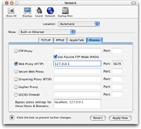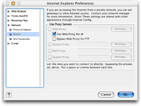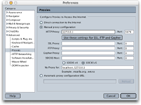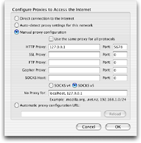
Home
 Products
Products
 SurfFast
SurfFast
 Support
Support
 Installation
Installation
 OSX
OSX
Below, you will see instructions for configuring OSX system settings,
as well as the Safari, Internet Explorer, Mozilla and Firefox browsers,
to use SurfFast as the Web proxy server. Go ahead and take a look at
the icon and browser name listed in the left column below and select
the one that you typically use:
System-Wide Configuration

(click on the image
for more details)
|
- Setting the proxy server at the system
level will not work with all browsers, most notably
Firefox and Mozilla, but will work with Safari and
Internet Explorer.
- Select System Preferences
from the Apple Menu, or
click on the preferences pane icon in the dock.
- Click on the icon labeled Network
(the black and blue globe) in the Internet
& Network group.
- Once the Network panel opens,
click on the Proxies tab.
- Then, click on the checkbox next to Web Proxy
(HTTP) and enter 127.0.0.1
in the first field and then enter 5678
in the Port field.
- And in the Bypass proxy settings ...
field, enter localhost, 127.0.0.1
in the text field.
- Finally, click on the Apply Now
button to finish.
|

|
Safari

(click on the image
for more details)
|
- Select Preferences... from the
Safari menu and then click on the
Advanced icon in the toolbar
at the top.
- Click on the Change Settings...
button, next to the Proxies
label.
- This will take you to the Proxies
tab in the Network control panel.
See instructions in the previous section for more information
on how to configure system-wide proxy settings.
|

|
Internet Explorer

(click on the image
for more details)
|
- Launch the Internet Explorer browser.
- Select Preferences... from the
Explorer menu.
- Expand the Network category
from the list of categories on the left.
- Click on the Proxies option.
- In the Use Proxy Servers pane,
click on the Use Web Proxy for all
checkbox.
- If the Settings... button is grayed
out, then you will have to go the
Network control panel; see the first
section for more information on on how to configure
system-wide proxy settings.
- Otherwise, click on the Settings...
button. In the new window that opens, enter
127.0.0.1 in the
Address field and enter
5678 in the Port field
and click on the OK button
to close it.
- Finally, enter localhost, 127.0.0.1
in the large text field at the bottom; the description
above the field will start with the List the
sites ... phrase.
- Click on the OK button to finish.
|

|
Mozilla

(click on the image
for more details)
|
- Launch the Mozilla Web browser.
- Select Preferences... from the
Mozilla menu.
- Expand the Advanced category
from the list of categories on the left.
- Click on the Proxies option.
- Select the Manual proxy
configuration radio button in the pane on the right.
- Enter 127.0.0.1 in the
HTTP Proxy field and
5678 in the
Port field.
- Finally, enter localhost, 127.0.0.1
in the No Proxy For field.
- Click on the OK button to finish.
|

|
Firefox

(click on the image
for more details)
|
- Launch the Firefox Web browser.
- Select Preferences... from the
Firefox menu.
- Click on the Connection Settings...
button at the bottom of the General
pane.
- Select the Manual proxy
configuration radio button in the new dialog box.
- Enter 127.0.0.1 in the
HTTP Proxy field and
5678 in the
Port field.
- Finally, enter localhost, 127.0.0.1
in the No Proxy for field.
- Click on the OK button to finish.
|
If you use a browser other than the ones covered here, you
will need to navigate to its Preferences
and look for a pane that allows you to configure network related
settings. Then, search for an area where you can set the proxy server
information and enter 127.0.0.1 for the
address/host, 5678 for the port and
localhost, 127.0.0.1 for the list of
addresses to bypass.
That's all there is to it!
|
|
|






 Products
Products
 SurfFast
SurfFast
 Support
Support
 Installation
Installation
 OSX
OSX